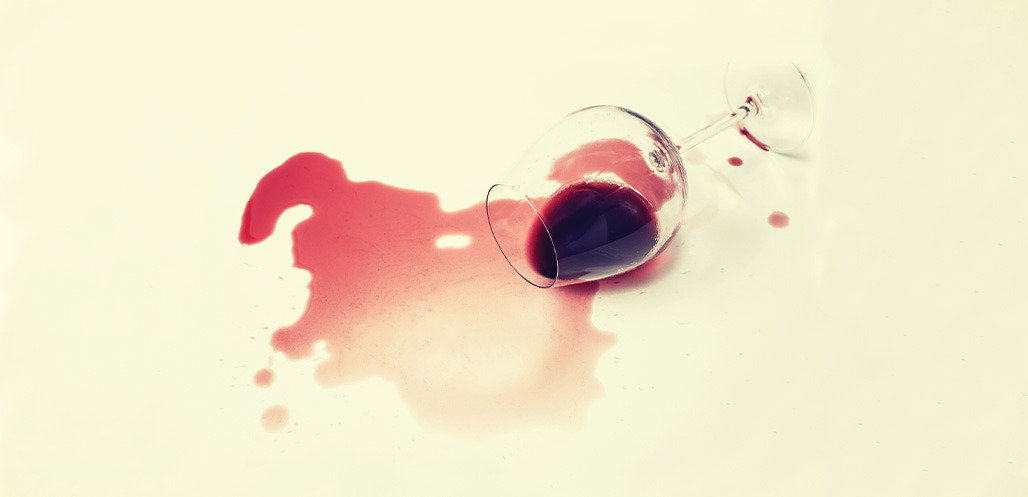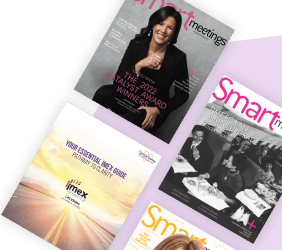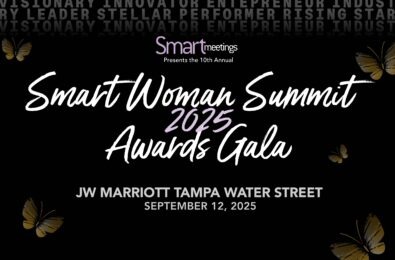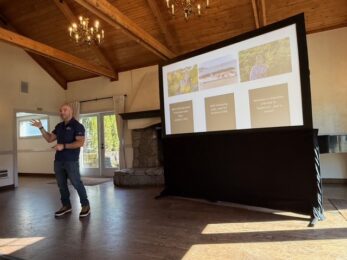Get ahead of the curve on changing perceptions of alcohol at events
When it comes to business events, it’s been a longstanding status—at this point, almost an expectation—that alcohol will be offered in an event setting. There’s a good reason for it: gifting.
David T. Stevens, co-founder and wellness architect at Olympian Meeting and host of the “Return on Wellness” podcast, says, “Alcohol can be expensive, so by offering people the best thing you had—the expensive thing—you were showing hospitality.”
Yet, nowadays, increasing numbers of people across the board are less interested in drinking alcohol and more interested in wellness. This trend is especially prevalent among younger people—the business events world’s incoming audience. In fact, a Gallup poll that assesses Americans’ views on alcohol consumption, which has been conducted 10 times since 2001, states in its 2024 edition that young adults are “leading the charge to drink less for better health.” Of all surveyed, 45% say that drinking one or two alcoholic beverages per day is bad for one’s health—a 6% increase since 2023 and a 17% increase since 2018.
As with anything, events must change as trends change. Stevens says, “The meaning of providing hospitality needs to keep up with what people’s preferences are. So, as people’s preferences are shifting away from being heavy drinkers, and you have this entire sector of the population that doesn’t drink alcohol, you should be prepared to offer something that ensures they get the same experience as those who do drink alcohol, so they’re still feeling that hospitality.”
Changing Trends
On Jan. 3, 2025, the U.S. Surgeon General, Dr. Vivek Murthy, issued a declaration calling for a cancer warning label on alcoholic beverages, stating that there is a need for increased awareness that alcohol is a leading cause of 20,000 cancer deaths annually in the U.S. This is one of the latest in widespread declarations as a result of increased awareness of the negative health effects of alcohol.
Read More: Is Your Event Inclusive? Why Non-Alcoholic Drinks Matter Year-Round
In 2023, the World Health Organization (WHO) issued a declaration stating that there was “no safe level” of alcohol consumption. This was in contrast to a long-established consensus that alcohol consumption in moderation had health benefits.
In 2025, the United States will update the U.S. Dietary Guidelines, which many in the alcohol industry fear will follow the WHO’s “no safe level” declaration or will suggest any level of reduction in alcohol consumption.
Crunching the Numbers
Wine Opinions and Colangelo & Partners conducted a 2024 poll of U.S. wine consumers to assess how they would respond to a potential change in the U.S. Dietary Guidelines reducing recommended alcohol consumption from its current two drinks per day for men and one drink per day for women to two drinks per week for all adults. The poll assessed responses from 2,013 people who drink wine at least two to three times or more per month, strictly with regard to their wine consumption. Overall, 15% indicated they would adopt the new guideline, while 21% indicated they would reduce their consumption but not to the new recommended level.
The poll revealed stark differences among different generations. While 30% of respondents under 40 stated they would adopt the new guideline, and 21% of respondents under 40 stated they would reduce consumption but not to the level of the new recommendation, those numbers were 7% and 13%, respectively, for respondents aged 40 to 59, and 5% and 11%, respectively, for those 60 or older.
The Gallup poll mentioned earlier demonstrates similar findings. Young adults’ self-reported alcohol consumption has trended downwards since the early 2000s. The 2024 poll shows that 59% of young adults (18-34) report that they drink, in comparison to polls from the early 2000s (2001 to 2003) in which 70% of young adults reported drinking. Meanwhile, in the 2024 poll, 69% of middle-aged adults (35-54) self-reported that they consume alcohol.
How Alcohol Affects the Attendee

It can’t go unsaid that, when alcohol is involved, there is always risk. It is a factor behind accidents, injuries or simply something said that made someone else uncomfortable.
Stevens addresses this, saying, “That isn’t to say you shouldn’t do it or that people shouldn’t drink at events. But sometimes, people just overindulge, and you have to have the right controls in place when that happens. It’s risk mitigation 101.”
These are the extreme cases. But alcohol affects the body in many more subtle ways that can impact an attendee’s experience, and these effects are some of the most cited reasons for abstaining among those who choose to do so. One of the leading reasons has to do with a growing consensus that alcohol has negative health effects, even in moderation, echoing the WHO’s “no safe level” declaration.
“The market is evolving, and we have to evolve to move with the market.”
– David T. Stevens, Olympian Meeting
(Not So) Sweet Dreams
Stevens says, “Alcohol has been scientifically proven to impede the production of melatonin, which erodes sleep quality. During sleep, you convert short-term memory to long-term memory.”
Stevens urges meeting planners to look at it in terms of ROI. After all the time, money and resources you’ve put into an event, “You have people up late, drinking, and the short amount of sleep they get is not good quality sleep. And then, they have to be up early the next morning. So, excess alcohol can compound a lack of ROI, because your attendees are not getting good quality sleep.”
Attention, Attention!
Jacques Martiquet, The Party Scientist, shares the social neuroscience approach to alcohol; in summary, alcohol produces dopamine in the brain—lots of it. Dopamine is called the “reward hormone” because it is produced when we do something beneficial or enjoyable, creating pleasure and motivation, and therefore causing us to want to repeat that behavior.
One of the central goals of an event is to facilitate successful networking and enable attendees to build lasting bonds with one another. This, Martiquet explains, is far more likely when we have oxytocin release, above dopamine. Oxytocin is the bonding hormone, impacting social bonding and long-term emotional attachment.
Listen Now: What One Thing? Finding Joy at Events with Jacques Martiquet The Party Scientist
When we have alcohol, we have lots of dopamine being produced in our brains, and we feel like we’re having a lot of fun and connecting with people. But if we go sans alcohol in an environment where we are connecting with people, we produce more oxytocin, and the bonds formed in that environment are stronger and more lasting than the bonds formed in a high-dopamine environment.
Another effect of alcohol, he explains, is increased GABA (Gamma-Aminobutyric Acid) in the brain. “GABA is the inhibitory neurotransmitter. This is why alcohol is a depressant. It reduces anxiety, physical energy and attention circuits. So, when alcohol is present, our self-awareness, attention and social skill application decrease—these skills that we know can create powerful bonds.”
The Disinhibition Effect
There’s a reason that we feel like we are bonding and building relationships when alcohol is involved. Martiquet says it is because alcohol has a disinhibition effect, that is, “When we’re disinhibited, we’re less crippled by our self-consciousness and trying to look beautiful, polite, formal, high status, et cetera. So when we stop trying to look good, we can relax and be more open to fuller human connection.”
However, creating disinhibition doesn’t require alcohol. “The sweet spot of disinhibition is when we’re willing to take social risks—like being less afraid to introduce ourselves to someone we haven’t met, we’re less afraid to laugh at ourselves, we’re less afraid to dance—but we’re still self-aware.”
When we have alcohol, we have lots of dopamine being produced in our brains, and we feel like we’re having a lot of fun and connecting with people. But if we go sans alcohol, and we are still connecting with people, we produce more oxytocin, and the bonds formed in that environment are stronger and more lasting than the bonds formed in a high-dopamine environment.
The Mocktail Movement
Stevens is an advocate for what he likes to call the “Yes, and” bar. When your event offers a bar, Stevens says, “It’s about having non-alcoholic options, so the person who doesn’t drink can have something. It’s not about forcing someone who drinks not to drink. It’s about making the people who don’t drink feel seen.”
Mocktails have been on the rise for some time. Stevens says that, in grocery stores, the non-alcoholic section used to be a shelf; then, it was a cooler. Now, it’s two or three coolers. This reflects the rising interest in non-alcoholic drinks. The events industry is on its way to catching up, yet it sometimes falls behind.
Priyanka and Chirasmita Kompella, co-founders of Zero Proofed, share, “As corporate women, we’ve learned that holding a drink in your hand is important for business, friendships and celebrations. Yet there are rarely booze-free options on the menu.”
Although interest in alcohol-free options at meetings and events has risen, and more planners have introduced options, they say, “It’s become clear that not all options are equal. Low-quality options such as sugary fountain sodas, from-concentrate fruit juices and mocktails packed with sugary syrup tend to alienate those that are prioritizing wellness, nutrition, balance or the need to moderate their sugar intake due to health reasons. In a growing effort to be inclusive, we’re seeing a rapidly growing interest in designing balanced and dignified alcohol-free cocktails.”
To create a high-quality non-alcoholic menu, the Kompella sisters recommend a well-balanced selection of non-alcoholic cocktails, beer and wine served in the same way as alcoholic drinks, and that this menu should incorporate a diverse set of flavors and textures: bubbly, still, bitter, sweet, dry and savory.
“Many people are decreasing their alcohol intake to support their health & wellness goals. When your guests have beverage options that support their wellness journey, they are more likely to feel included and well taken care of,” say the Kompella sisters.
The Industry Evolves
IMEX 2024 was the first year that the hashtag #DRIMEX was in use by the official IMEX handle. The hashtag has been around at least since the first IMEX post-pandemic, Stevens says. “I didn’t drink, and there were a few others, and we were all using #DRIMEX. We weren’t spelling it right. We were writing D-R-Y-I-M-E-X, instead of D-R, capital I, which, fair enough,” he laughs. “But, the IMEX handle used it this year—and I was like, we have made a leap. And I applaud them for leaning into this concept of hospitality and meeting people where they are. That action exemplifies it. That makes all of those people feel like they’re a part of this event.”
Event Design to Engage

There are plenty of ways to produce an environment for oxytocin-fueled connection to take place, and to make sure attendees have fun in an alcohol-free or low-alcohol environment.
Martiquet suggests that the design of the social events is crucial, but what we do leading up to that social event matters enormously, too. “How do we design the whole event experience so that people are naturally disinhibited? Well, we change how we greet guests, how we open the event, how we open each breakout. We facilitate lunchtime connections. We do more community-centric sessions versus speaker-oriented sessions,” he says.
“The goal is to design experiences that facilitate that oxytocin release so that guests are bonding with each other on a neurochemical level.”
– Jacques Martiquet, The Party Scientist
Then, it’s about the social event and how it’s designed. “Diversify the activities. So maybe there’s a little roundtable and we have an icebreaker game going on. Maybe there are some arcade games. Maybe we have a roaming entertainer.” When you have people gather around some arcade games, there’s something to talk about, an activity to do, a spirit of competition; this is especially helpful for those attendees who find socializing a little difficult, and might be even more attractive to attendees than a reception with an open bar.
What about a team-building activity where participants get to build their own non-alcoholic cocktail? Priyanka and Chirasmita Kompella say, “[This kind of activity would] allow participants to engage creatively, learn about unique ingredients and collaborate in a way that feels accessible to everyone. These activities break the mold of traditional, alcohol-centered events and offer a fresh, inclusive and safe way to bring people together, making them particularly appealing for corporate settings looking to foster connection and creativity,” express the Kompella sisters.
It all goes back to recognizing what attendees, here and now, want. Martiquet says, “There is this wellness movement that is undeniable; alcohol is on its way out. We already know that. People are more interested in wellness. So it is time to get ahead of the curve and start designing experiences that supersede alcohol-based experiences—that are superior in design to open bar experiences.”
The Case for Budget
Let’s face it: Alcohol is expensive. That’s why it became a part of gifting at events. If you’re offering an open bar at events, ensuring that there are quality mocktail options available shouldn’t impact your price to a large degree. It comes down to working with your venues and suppliers. “The truth of the matter is,” Stevens says, “If you’re doing an open bar, you should be asking your venue to ensure that they are offering quality non-alcoholic drinks, if that is not already part of their open bar package.”
Read More: Wellness on a Budget: Five Cost-Effective Ideas to Elevate Wellness in Your Meetings
Stevens says it’s important to pay attention to the words we use. There are alcohol-free options like sodas and juices, but the term mocktail refers to something that uses a non-alcoholic liquor, of which there are many—Zero Proof, Seedlip and Free Spirits are just a few of the well-known brands. Stevens says, “A bottle of one of those might cost around $50, which is the same price a bottle of liquor costs,” Stevens says. “So, it’s the same price. Either way, alcoholic or non-alcoholic liquor, you’re paying the same price, so your bar might as well include it. There’s no reason your budget should go up to offer mocktails—if anything, it might go down.”
Plus, when you’re saving money in your alcohol budget, it might create just the space you need for those engaging activities and event design elements that make the reception that much more fun and engaging, and that facilitate the kind of oxytocin-releasing connection opportunities that create even better ROI.
Conclude to Include

Ultimately, it’s about inclusion. Stevens says, “I’d love it if we got to a point where everyone in that room is holding a glass and everything looks so good that nobody is asked, ‘Oh, why aren’t you drinking?’ When that statement no longer exists, that’s when we know we have an environment where everyone feels included.”
“When your guests have beverage options that support their wellness journey, they are more likely to feel included and well taken care of”
– Priyanka and Chirasmita Kompella, Zero Proofed
When you have attendees who aren’t interested in alcohol, they probably aren’t as interested in a reception built around an open bar either, so event organizers now have the challenge—and opportunity—to imagine new ways of gathering people and encouraging networking that is more meaningful and more lasting.
With the research on our side, we know that real ROI comes from environments where attendees can feel disinhibited, energized, welcome and comfortable connecting with one another. So, when the new generation of event attendees is asking for events to feature a little more sparkle to make that happen, how could we say no?
The J-Curve
The long-established consensus that moderate alcohol consumption has some health benefits has a name: the J-curve argument. Based on a number of studies that support moderate drinking, the J-curve argues that those who drink moderate amounts of alcohol face lower mortality rates than those who drink heavily and those who don’t drink at all, through a graph resembling a “J,” with mortality rates on the y-axis and, on the x-axis, non-drinkers at the far left, moderate drinkers at the dip in the middle and heavy drinkers at the far right.
Many scientists, however, challenge the validity of these findings, arguing that the measurement excludes other factors such as healthy lifestyle behaviors associated with moderate drinkers and that many non-drinkers avoid alcohol for other health reasons that might make consuming alcohol higher risk for them. The J-curve has never been subjected to a randomized control study and remains a hypothesis. Research around whether or not moderate drinking has any health benefits, or potentially has negative effects on health, is still not quite clear.
This article appears in the January/February 2025 issue. You can subscribe to the magazine here.




